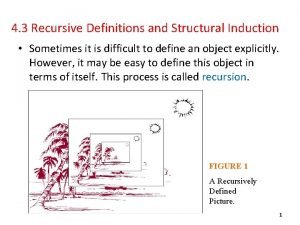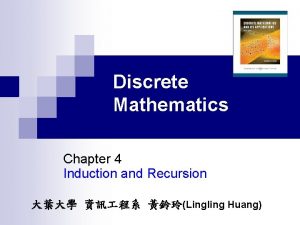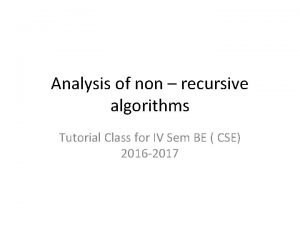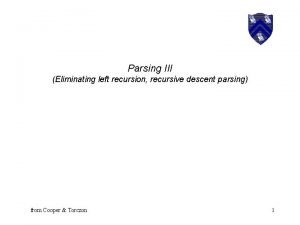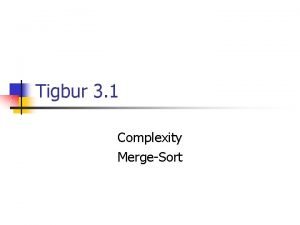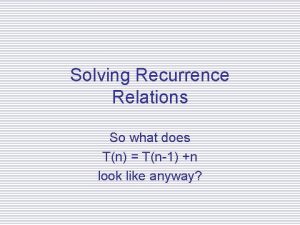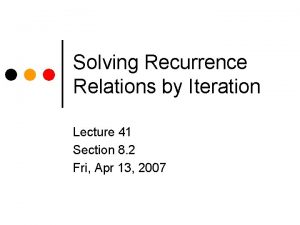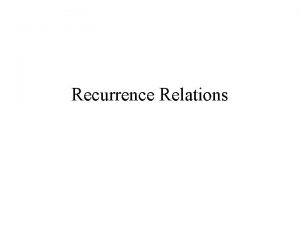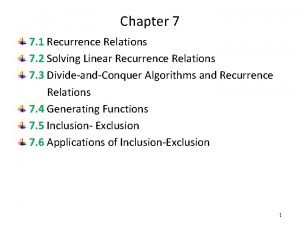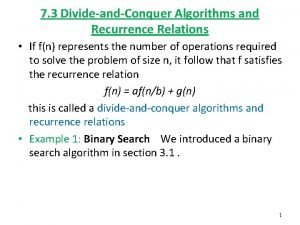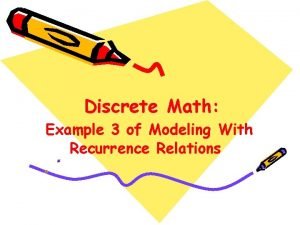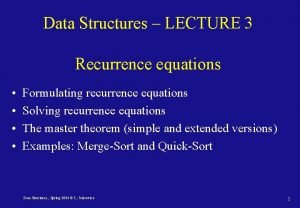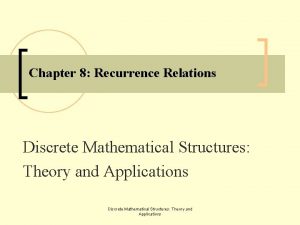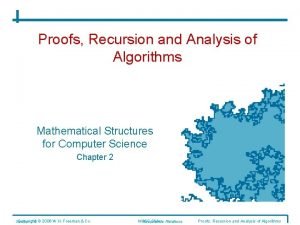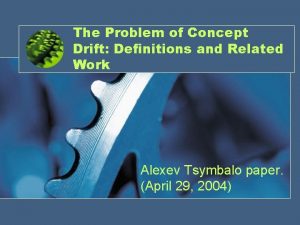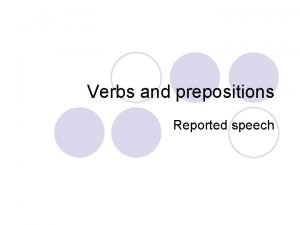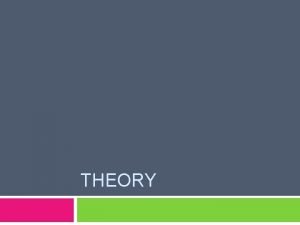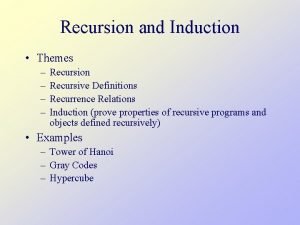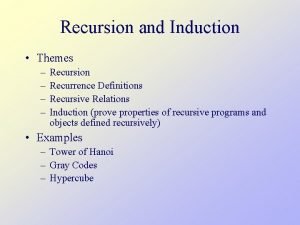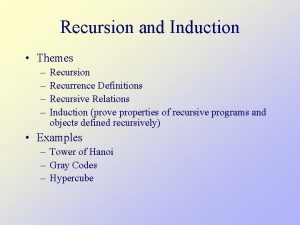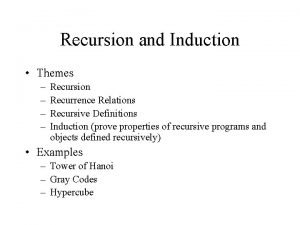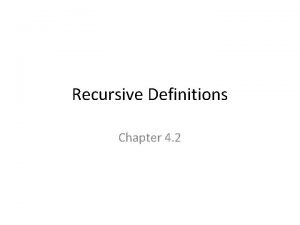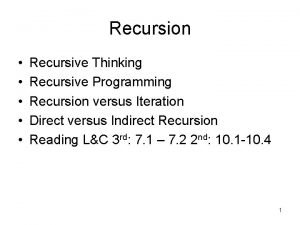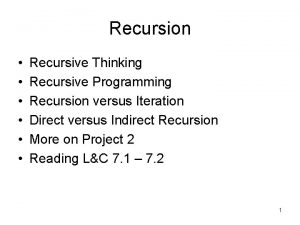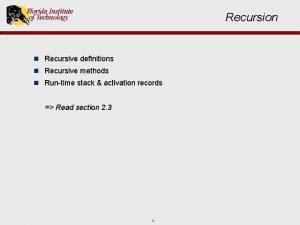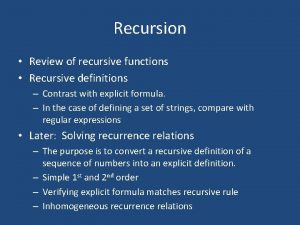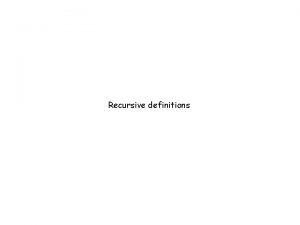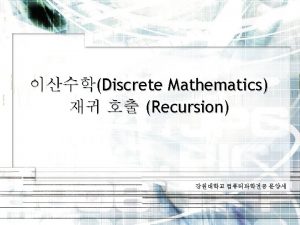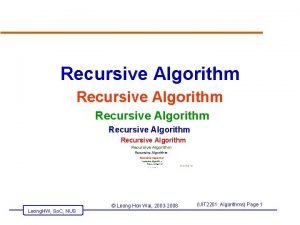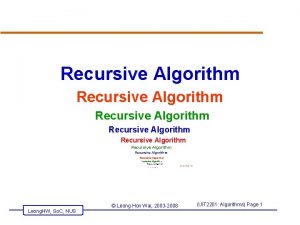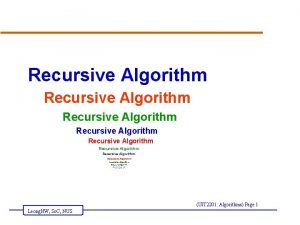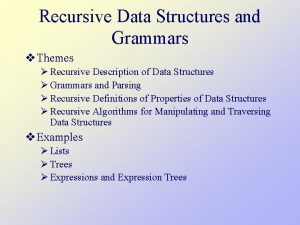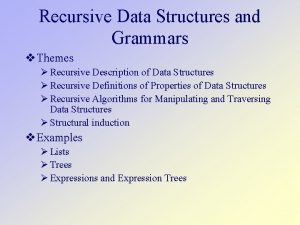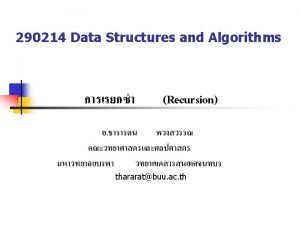Recursion and Induction Themes Recursion Recursive Definitions Recurrence































![Binary-Reflected Gray Code • G 1 = [0, 1] • Gn = [0 Gn-1, Binary-Reflected Gray Code • G 1 = [0, 1] • Gn = [0 Gn-1,](https://slidetodoc.com/presentation_image/00cbdaa6bd007d68a432a75adca5219e/image-32.jpg)
![Iterative Formula • Let Gn(i) be a function from [0, …, 2 n-1] • Iterative Formula • Let Gn(i) be a function from [0, …, 2 n-1] •](https://slidetodoc.com/presentation_image/00cbdaa6bd007d68a432a75adca5219e/image-33.jpg)











- Slides: 44

Recursion and Induction • Themes – – Recursion Recursive Definitions Recurrence Relations Induction (prove properties of recursive programs and objects defined recursively) • Examples – Tower of Hanoi – Gray Codes – Hypercube

Tower of Hanoi • There are three towers • 64 gold disks, with decreasing sizes, placed on the first tower • You need to move the stack of disks from one tower to another, one disk at a time • Larger disks can not be placed on top of smaller disks • The third tower can be used to temporarily hold disks

Tower of Hanoi • Assume one disk can be moved in 1 second How long would it take to move 64 disks? N disks? • To create an algorithm to solve this problem, it is convenient to generalize the problem to the “N-disk” problem, where in our case N = 64.

Recursive Solution

Recursive Solution

Recursive Solution

Recursive Solution

Tower of Hanoi

Tower of Hanoi

Tower of Hanoi

Tower of Hanoi

Tower of Hanoi

Tower of Hanoi

Tower of Hanoi

Tower of Hanoi

Recursive Algorithm define hanoi (n, from, to, using) if n = 1 then move(from, to) else hanoi(n-1, from, using, to) move(from, to) hanoi(n-1, using, to, from)

Correctness • Use induction to prove that the recursive algorithm solves the Tower of Hanoi problem. • Let H(n, a, b, c) = property that hanoi(n, a, b, c) moves n disks from tower a to b using tower c without placing larger disks on top of smaller disks

Correctness • Base case: • H(1, a, b, c) works since hanoi(1, a, b, c) = move(a, b) • Inductive Hypothesis (IH): • Assume H(n, a, b, c) is correct for arbitrary a b c • Show IH H(n+1, a, b, c) • The first recursive call correctly moves n disks from tower a to tower c [by IH] • moves the largest disk to the empty tower b (all other disks on tower c) • The second recursive call correctly moves n disks from tower c to tower b on top of largest disk

Cost • The number of moves M(n) required by the algorithm to solve the n-disk problem satisfies the recurrence relation – M(n) = 2 M(n-1) + 1 – M(1) = 1

Cost • We’d like to find a closed form, a formula that is not a recurrence relation • We can do this a couple ways: – We can guess at the answer (and then prove it, of course) – We can unwind the recurrence (still need to prove it)

Guess and Prove • Calculate M(n) for small n and look for a pattern. • Guess the result and prove your guess correct using induction. n M(n) 1 1 2 3 3 7 4 15 5 31

Proof by Induction • Base case: M(1) = 1 = 21 -1 • Inductive Hypothesis (IH) • Assume M(n) = 2 n-1 • Show IH M(n+1) = 2 n+1 -1 • M(n+1) = 2 M(n) + 1 • = 2(2 n-1) + 1 [by IH] • = 2× 2 n -1= 2 n+1 -1

Substitution Method • Unwind recurrence, by repeatedly replacing M(n) by the r. h. s. of the recurrence until the base case is encountered. M(n) = 2 M(n-1) + 1 = 2*[2*M(n-2)+1] + 1 = 22 * M(n-2) + 1+2 = 22 * [2*M(n-3)+1] + 1 + 2 = 23 * M(n-3) + 1+2 + 22

Geometric Series • After k steps: (prove by induction on k) M(n) = 2 k * M(n-k) + 1+2 + 22 + … + 2 k-1 • Base case, M(1), encountered when n-k=1 => k = n-1 • Substituting in, to get rid of all of the k’s: M(n) = 2 n-1 * M(1) + 1+2 + 22 + … + 2 n-2 = 1 + 2 + … + 2 n-1 = = 2 n – 1 • Use induction to reprove result for M(n) using this sum. Generalize by replacing 2 by x.

Induction • After k steps: (prove by induction on k) M(n) = 2 k * M(n-k) + 1+2 + 22 + … + 2 k-1 (1 ≤ k < n) • Base case: • Using recurrence after 1 step M(n) = 2 M(n-1) + 1 • Induction Hypothesis M(n) = 2 k * M(n-k) + 1+2 + 22 + … + 2 k-1 • Show IH M(n) = 2 k+1 * M(n-(k+1)) + 1+2 + 22 + … + 2 k

Induction • Show IH M(n) = 2 k+1 * M(n-(k+1)) + 1+2 + 22 + … + 2 k M(n) = 2 k * M(n-k) + 1+2 + 22 + … + 2 k-1 [IH] = 2 k * (2 M(n-k-1)+1) + 1+2 + 22 + … + 2 k-1 [recurrence] = 2 k *2 M(n-k-1)+ 2 k + 1+2 + 22 + … + 2 k-1 = 2 k+1 *M(n-(k+1)) + 1+2 + 22 + … + 2 k

Geometric Series

Worst Case • Is it possible to solve Hanoi in fewer than 2 n-1 moves? • Let M*(n) be the fewest moves required to solve H(n, a, b, c) • Claim M*(n) 2 M*(n-1) + 1 [why? ] • Use induction to show M*(n) 2 n-1

Gray Code • An n-bit Gray code is a 1 -1 onto mapping from [0. . 2 n-1] such that the binary representation of consecutive numbers differ by exactly one bit. • Invented by Frank Gray for a shaft encoder - a wheel with concentric strips and a conducting brush which can read the number of strips at a given angle. The idea is to encode 2 n different angles, each with a different number of strips, corresponding to the n-bit binary numbers.

Shaft Encoder (Counting Order) 010 011 100 001 000 111 101 110 Consecutive angles can have an abrupt change in the number of strips (bits) leading to potential detection errors.

Shaft Encoder (Gray Code) 011 010 110 001 000 111 101 Since a Gray code is used, consecutive angles have only one change in the number of strips (bits).
![BinaryReflected Gray Code G 1 0 1 Gn 0 Gn1 Binary-Reflected Gray Code • G 1 = [0, 1] • Gn = [0 Gn-1,](https://slidetodoc.com/presentation_image/00cbdaa6bd007d68a432a75adca5219e/image-32.jpg)
Binary-Reflected Gray Code • G 1 = [0, 1] • Gn = [0 Gn-1, 1 Gn-1], G reverse order complement leading bit • G 2 = [0 G 1, 1 G 1] = [00, 01, 10] • G 3 = [0 G 2, 1 G 2] = [000, 001, 010, 111, 100] • Use induction to prove that this is a Gray code
![Iterative Formula Let Gni be a function from 0 2 n1 Iterative Formula • Let Gn(i) be a function from [0, …, 2 n-1] •](https://slidetodoc.com/presentation_image/00cbdaa6bd007d68a432a75adca5219e/image-33.jpg)
Iterative Formula • Let Gn(i) be a function from [0, …, 2 n-1] • Gn(i) = i (i >> 1) [exclusive or of i and i/2] – G 2(0) = 0, G 2(1) = 1, G 2(2) = 3, G 2(3) = 2 • Use induction to prove that the sequence Gn(i), i=0, …, 2 n-1 is a binary-reflected Gray code.

Gray Code & Tower of Hanoi • Introduce coordinates (d 0, …, dn-1), where di {0, 1} • Associate di with the ith disk • Initialize to (0, …, 0) and flip the ith coordinate when the i-th disk is moved • The sequence of coordinate vectors obtained from the Tower of Hanoi solution is a Gray code (why? )

Tower of Hanoi (0, 0, 0)

Tower of Hanoi (0, 0, 1)

Tower of Hanoi (0, 1, 1)

Tower of Hanoi (0, 1, 0)

Tower of Hanoi (1, 1, 0)

Tower of Hanoi (1, 1, 1)

Tower of Hanoi (1, 0, 1)

Tower of Hanoi (1, 0, 0)

Hypercube Graph (recursively defined) n-dimensional cube has 2 n nodes with each node connected to n vertices Binary labels of adjacent nodes differ in one bit 110 10 0 11 00 011 010 1 111 100 01 000 101 001

Hypercube, Gray Code and Tower of Hanoi A Hamiltonian cycle is a sequence of edges that visit each node exactly once and ends at a node with an edge to the starting node A Hamiltonian cycle on a hypercube provides a Gray code (why? ) 110 111 010 100 000 101 001
 Recursive definitions and structural induction
Recursive definitions and structural induction Recurrence relation of recursive selection sort
Recurrence relation of recursive selection sort Induction and recursion discrete mathematics
Induction and recursion discrete mathematics Non recursive algorithm
Non recursive algorithm Left recursion and left factoring
Left recursion and left factoring To understand recursion you must understand recursion
To understand recursion you must understand recursion Divide and conquer recurrence
Divide and conquer recurrence Rabbits and recurrence relations
Rabbits and recurrence relations Mergesort recurrence relation
Mergesort recurrence relation Recurrence rate
Recurrence rate Recurrence relation for linear search
Recurrence relation for linear search Solve the recurrence relation
Solve the recurrence relation Linear homogeneous recurrence
Linear homogeneous recurrence Master method
Master method Recurrence computer science
Recurrence computer science Hsv-2 oral transmission rates
Hsv-2 oral transmission rates Recurrence relation
Recurrence relation Asymptotic run time
Asymptotic run time Algorithm recurrence relation
Algorithm recurrence relation Unrolling the recurrence
Unrolling the recurrence Recurrence relation
Recurrence relation Recurrence discrete math
Recurrence discrete math Recurrence data structures
Recurrence data structures Recurrence relation in discrete mathematics
Recurrence relation in discrete mathematics What is recurrence equation
What is recurrence equation Advanced counting techniques
Advanced counting techniques Bsbhrm506
Bsbhrm506 Dramatic irony in julius caesar
Dramatic irony in julius caesar The problem of concept drift: definitions and related work
The problem of concept drift: definitions and related work The correct shutoff procedure for an oxyacetylene torch is:
The correct shutoff procedure for an oxyacetylene torch is: How to measure for birdsmouth cut
How to measure for birdsmouth cut Revision materials
Revision materials What does asset mean in hatchet
What does asset mean in hatchet Newsworthy values
Newsworthy values Comparison and contrast definition
Comparison and contrast definition Cscmp supply chain management definitions and glossary
Cscmp supply chain management definitions and glossary Undefined terms definition
Undefined terms definition Serongagandi description
Serongagandi description Film genres and definitions
Film genres and definitions Nominal and operational definitions
Nominal and operational definitions Lesson 2-4 biconditional statements and definitions
Lesson 2-4 biconditional statements and definitions Full penetration butt weld symbol
Full penetration butt weld symbol Reported speech already
Reported speech already Examples of reciprocal determinism
Examples of reciprocal determinism Restaurant terms and definitions
Restaurant terms and definitions
